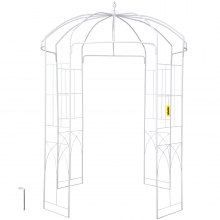VEVOR Explores The Intersection of Art and Nature In Garden Arches
The meeting of arts and architecture can only result in one thing: tranquility. Fortunately, the bustling and restless urban landscapes that usually seek nature’s embrace have ways to contact the earth. Various innovations, including garden arches, seamlessly blend parts of everyday urban lifestyles with the allure of nature.
A garden arch is a decorative structure usually at the entrance of an outdoor space that also supports climbing plants. Garden arches function in various places, from events to residential homes. In all, manufacturers like VEVOR can make them the unique confluence of nature and arts.
Benefits Of Garden Arches
Garden arches are getting more popular daily, and for the right reasons. Beyond traditional decorative features, they offer psychological, physical, and emotional benefits to the environment and people around them.
Aesthetic Enhancement
One of the most evident advantages of garden arches is their capacity to improve the aesthetics of outdoor spaces. Garden arches, with their beautiful and flowing shapes, bring refinement and appeal to gardens, paths, and entrances.
They act as focal points, drawing attention and providing structure and balance to the scene.
Define Space and Create Structure
Garden arches can be carefully placed to delineate boundaries, walkways, and distinct regions of a garden. Garden arches contribute to a feeling of order and structure by demarcating places, leading visitors around the environment, and promoting discovery.
They also provide a sensation of containment and intimacy, changing wide spaces into private sanctuaries.
Shade and Privacy
One of the practical uses of garden arches is to support climbing plants like roses, jasmine, wisteria, and clematis. The arch construction creates an anchor for these plants to climb and thrive, resulting in a gorgeous vertical garden impression.
This not only beautifies and colors the environment, but it also makes the most use of available space, particularly in smaller gardens.
Different Materials Of Garden Arches
Garden arches come in various materials to satisfy different tastes, architectural styles, and needs. Each material type offers unique features and advantages, making their suitability different.
Wood
Wooden garden arches ooze comfort, charm, and natural beauty, making them a popular choice for both rustic and classic gardens. Wooden arches, often made of hardwoods such as cedar, redwood, or oak, fit perfectly with their surroundings and age beautifully over time.
They can be left untreated for a worn appearance or stained and sealed to increase their longevity and resilience to the elements. Wooden garden arches are adaptable and may be tailored in size, form, and style.
Metal
Metal garden arches are highly valued for their durability, strength, and timeless elegance. Wrought iron arches, with their complex scrollwork and artistic motifs, provide romance and refinement to gardens and walks. Steel arches create a sleek and modern appearance, while aluminum arches are lightweight and corrosion-resistant.
Metal arches can be polished to develop a natural patina or powder-coated for increased corrosion and weather resistance. They are suitable for both traditional and contemporary garden designs.
Composite Materials
Composite garden arches combine the advantages of many materials, providing strength, durability, and adaptability. Fiberglass arches are lightweight, weather-resistant, and can be formed into various forms and styles.
They have the appearance of natural materials such as wood or stone while providing greater durability and lifespan. Resin arches, composed of synthetic polymers, are lightweight, waterproof, and almost maintenance-free. They come in various finishes and colors, providing creative garden design options.
How To Select The Ideal Plants for Your Garden Arch
One major selling point of garden arches is being able to infuse plants into them. Whether you use it to support already growing plants or incorporate new plants into them, they can bring life into your space. You should know what to consider before adding a plant to your garden arch.
You should know what to consider before adding a plant to your garden arch. Adequate consideration benefits you, the plants, and other parts of the environment.
Assess Growing Conditions
Start by assessing the growing conditions around your garden arch, including sunlight exposure, soil type, and moisture levels. Determine whether the area receives full sun, partial shade, or full shade throughout the day, as this will influence your plant selection.
Additionally, consider the soil pH, drainage, and moisture retention characteristics to ensure your chosen plants thrive in their environment
Consider Climbing or Vining Plants
Garden arches support climbing or vining plants that may grow vertically and cover the structure with leaves, blooms, or both. Choose climbing plants like roses, clematis, honeysuckle, wisteria, jasmine, morning glory, or climbing hydrangeas.
These plants will grow in tandem with the arch's construction, resulting in a lush and green display that adds texture, color, and scent to your landscape.
Coordinate Colors and Textures
Select plants that complement your garden's current color palette and textures to create a beautiful and coherent design. When choosing flowering vines or foliage plants, keep the arch's hues in mind and the surrounding plants and hardscape features.
Mix different plant kinds to provide visual interest and depth, using contrasting colors, forms, and textures to create a dynamic and eye-catching display.
Why Choose VEVOR Garden Arches?
VEVOR is a premier in enhancing outdoor spaces. As veterans in the game, we understand your needs regarding garden arches, and our products prove our expertise.
VEVOR’s garden arches have gotten great reception on the market, with them being some of the best-selling. Relying on established and trustworthy like Amazon, reviews have shown that VEVOR’s garden arches have great sales data and excellent reviews.
Many confirmed buyers agreed that our garden arches are durable and made of high-quality materials. Understanding the intersection of their agricultural and aesthetic purposes, we ensure their styles while ensuring they are not toxic to plants or humans.
VEVOR’s garden arches have innovative designs and features, enabling them to fit into different styles and spaces. Whether for interior or event decor, VEVOR’s garden arches offer flexibility, aesthetics, and utility.
FAQs About Garden Arches
How do I care for and maintain my garden arch?
Garden arches require different levels of upkeep based on their material and design. Routine maintenance may involve cleaning, painting, or staining (for wooden or metal arches), trimming or training climbing plants, and looking for signs of damage or wear.
Are garden arches easy to install?
The design, size, and material of the garden arch, as well as the intricacy of the installation location, all influence how easy it is to install. Some garden arches come with pre-drilled holes and assembly guides for easy DIY installation, while others may necessitate expert installation, particularly for bigger or more complicated designs.
Can garden arches be customized to fit specific design preferences?
Yes, many garden arch manufacturers provide customization choices to ensure the arch meets your design preferences and requirements. Customization choices may include selecting the arch's material, size, form, finish, and decorations to match your specific design and landscape demands.





































































































